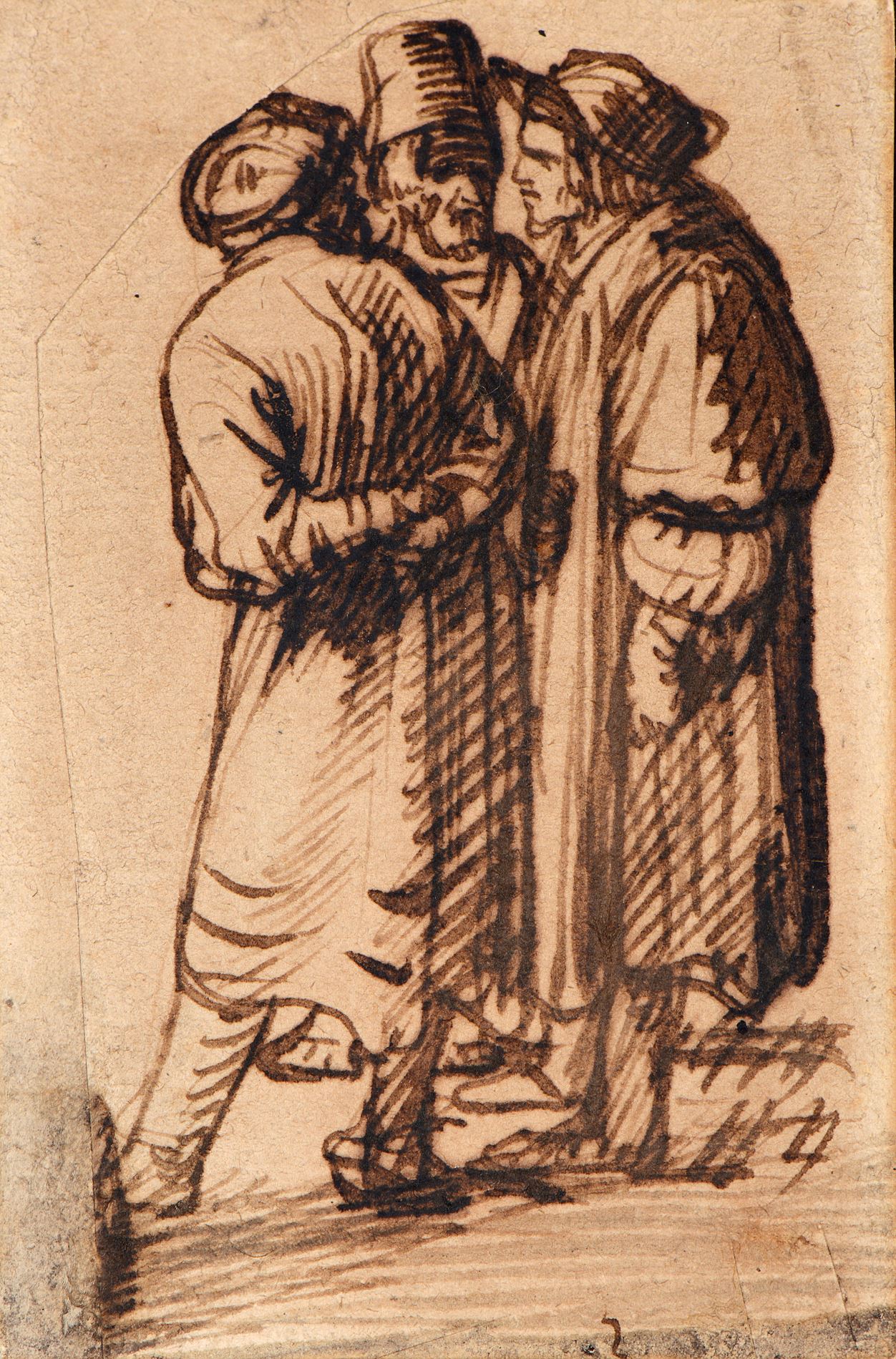Hendrick GOUDT
(The Hague 1583 - Utrecht 1648)
Three Orientals in Conversation
Sold
Pen and brown ink on buff paper, laid down.
Inscribed B and numbered 11 on the verso.
Irregularly trimmed and made up at the left edge and uoper left corner.
A small made up section at the lower right.
91 x 60 mm. (3 5/8 x 2 3/8 in.)
Inscribed B and numbered 11 on the verso.
Irregularly trimmed and made up at the left edge and uoper left corner.
A small made up section at the lower right.
91 x 60 mm. (3 5/8 x 2 3/8 in.)
This is one of a group of figure drawings, long regarded as works by Adam Elsheimer, that are now given to Hendrick Goudt. Among stylistically comparable drawings by Goudt is a study of Four Standing Woman with Babies and Two Children in the P. & N. de Boer Foundation in Amsterdam, a drawing of a draped figure seen from behind in the Museum Boijmans-van Beuningen in Rotterdam, and a drawing of five figures in the National Gallery of Scotland. Also similar are a study of two men in the Ashmolean Museum in Oxford and a drawing of a man and woman, seen from behind, in the Kupferstichkabinett in Berlin. Similar compositional groups of three standing men in conversation are found in small drawings by Goudt in a private collection in New York and in the Kupferstichkabinett in Berlin.
Little is known of Hendrick Goudt’s artistic training, but it is thought that he studied calligraphy and engraving with Jan van de Velde the Elder, and may have also had lessons in printmaking from Simon Frisius. As a draughtsman, he was strongly influenced by Jacques de Gheyn II, with whom he may have studied in his native city of The Hague. Goudt is thought to have travelled to Italy in 1604, and by 1607 is recorded as living in the house of the German painter Adam Elsheimer in Rome. He is again documented there in 1609, although it remains unclear whether he was formally a pupil of the elder artist. Goudt was, nevertheless, the artist closest to Elsheimer, and made a handful of superb prints after the latter’s paintings which served to spread the posthumous reputation of the German painter and, by extension, his own. (Indeed, Goudt’s entire oeuvre as a printmaker consists of seven engravings after Elsheimer.) Following Elsheimer’s death in 1610, Goudt returned to the Netherlands - taking with him a number of paintings by Elsheimer that he had acquired and of which he made engravings - and by 1611 had settled in Utrecht, where he is recorded as a member of the local guild of artists. He seems to have stopped working after the last of his prints after Elsheimer was published, in 1613. Around 1620 Goudt seems to have become severely mentally ill, and by 1625 had been declared legally incompetent. He died in 1648, suffering from mental derangement.
As a draughtsman, Goudt worked primarily in pen and ink, producing figural groups, landscapes and Biblical subjects. He also made a number of highly detailed pen and ink drawings on vellum for collectors, as well as a handful of engravings printed on silk. His drawings are difficult to accurately date, however, since only one sheet is dated; a copy of a print by Lucas van Leyden, executed in 1600. While Goudt’s early drawings show the influence of De Gheyn, his mature draughtsmanship is heavily indebted to the manner of Elsheimer; indeed, the figure drawings of the two artists have long been confused. Indeed, an album of nearly 180 drawings of figural groups by Goudt, in the collection of the Städel Museum in Frankfurt, was acquired by the museum in 1868 as the work of Elsheimer.
Provenance
Iohan Quirijn van Regteren Altena, Amsterdam (his posthumous sale stamp [Lugt 4617] on the verso)
Thence by descent until 2014.
Literature
Hans Möhle, Die Zeichnungen Adam Elsheimers. Das Werk des Meisters und der Problemkreis Elsheimer - Goudt, Berlin, 1966, p.56, illustrated pl.9, no.G16; Jeroen Giltaij, Le cabinet d’un amateur: Dessins flamands et hollandaises des XVIe et XVIIe siècles d’une collection privée d’Amsterdam, exhibition catalogue, Rotterdam and elsewhere, 1976-1977, p.36, no.63, illustrated pl.76.
Exhibition
Rotterdam, Museum Boymans-van Beuningen, Paris, Institut Néerlandais and Brussels, Bibliotheque Albert Ier, Le cabinet d’un amateur: Dessins flamands et hollandaises des XVIe et XVIIe siècles d’une collection privée d’Amsterdam, 1976-1977, no.63.




